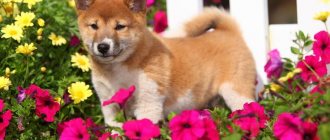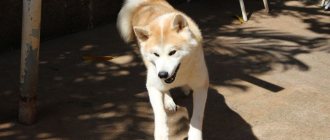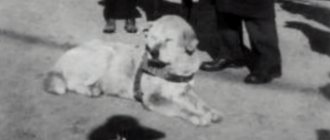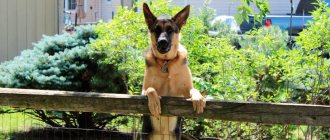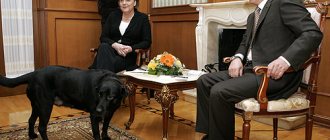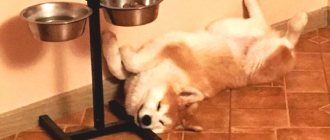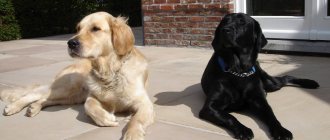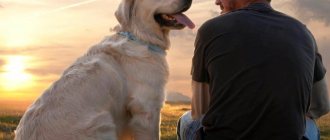External differences
The difference between Shiba Inu and Akita becomes obvious when you put them side by side. By looking at the main characteristics, you can find out what the difference is between the two breeds.
| Parameter | Akita | Shiba |
| Size at withers | 61-67 cm | 37-41 cm |
| Weight | 40-50 kg | 7-13 kg |
| Color | red-fawn, sesame, brindle and white | red, black and tan, zoned, white |
Size is the most striking distinguishing feature. The height of a male Akita can reach 67 cm, females - 64 cm, weight up to 50 kg. Shiba is almost half the size. The maximum height for a male is 40 cm, for a female - 38 cm, weight up to 13 kg.
The presence of an urajiro (a white mask on the face) is a mandatory standard for both breeds. Its absence is considered a vice.
Akita photo
Dogs also differ in coat type. The Akita has a three-layer coat. Consists of hard guard hair of varying lengths and soft, dense undercoat. There are individuals with both short and longer hair. The long hair of the Akita is regarded as a disadvantage, and such specimens are subject to rejection.
Photo of a Shiba.
The Shiba has a double coat consisting of a coarse, straight guard and a dense, fluffy undercoat.
To avoid confusion: the main differences between Akita Inu and Shiba Inu
The similarity between the two breeds is not surprising, given that one of them is the ancestor of the other. First, Shiba Inus appeared in Japan. This was in the 3rd century BC. Already in the sixth century, communities were organized in Japan that developed the first Shiba Inu standards and compiled instructions for care, maintenance and training.
Shiba Inu is also called Shiba Inu or Shiba Ken
Eastern dog breeders crossed the Shiba Inu with other breeds as experiments. By crossing the Shiba Inu with the Tosa Inu and mastiffs, a new type of dog emerged (this happened around the 15th century). These turned out to be quite large and strong dogs, suitable for hunting wild boars, deer and even bears. The breed was named Akita Inu.
Akita Inu is also called Japanese Akita or Matagi-ken.
Difference in structure and appearance
In fact, you can only confuse Akita Inu and Shiba Inu in pictures or by briefly looking at the dogs from afar. When two dogs of these breeds stand side by side, their significant difference in size immediately catches the eye. The Akita Inu is larger than its counterpart - the height at the withers of an adult is 61–67 cm, and the weight reaches 50 kg. The Shiba Inu grows up to 39 cm in height and weighs about 10–12 kg.
The difference in size between Shiba Inu and Akita Inu of the same age is obvious
Similar features include a round muzzle with expressive cheeks, wide and slightly slanted eyes of a dark color, neat high-set triangular ears and a tail curled into an elastic ring. Otherwise, these are completely different dogs:
- Akita Inu have a wider and shorter muzzle, making them look like cubs.
- Shiba Inu have sharper teeth, but Akita Inu have a stronger bite.
- The Akita Inu's body is denser, with a broad chest. The back of the Shiba Inu is narrower.
- The Akita Inu's hind legs are slightly higher than the front legs, while the Akita Inu's have the same height.
- The Shiba Inu has a less thick and dense coat, while the Akita Inu has softer hair to the touch.
- The color of the Shiba Inu can be red, black and tan and sesame. Akita Inu - pure white, red and white, brindle.
The public's favorite Hachiko is an Akita Inu, as evidenced by his size and character.
Video: comparison of Shiba Inu and Akita Inu
Difference in character
Puppies of both breeds are distinguished by considerable playfulness and curiosity. The difference is that as the Akita Inu gets older, it becomes a calmer and more reasonable dog, while the Shiba Inu may retain puppy mischief for the rest of its life. The common thing is that representatives of these breeds quickly learn commands and obey their owner. Just remember that both Akita Inu and Shiba Inu are stubborn, willful, and touchy. That is why, when training, you need to show calm and patience, not raise your voice, and especially not threaten with physical punishment.
The Shiba Inu (on the right) even as an adult retains the spontaneity of a puppy, while the Akita Inu (on the left) is a rather stern dog
Akita Inu are quite tolerant towards other dogs, but they are not particularly friendly (they only communicate with well-known dogs). If it seems to them that someone is threatening them or their owners, they immediately go on the attack (these are hunting animals, they are strong in a fight). They don’t particularly like small children, so families with small children are better off not getting such dogs.
The Shiba Inu is more tolerant of both other animals and small children. In the house, Sibas get along even with cats. Just don’t let your dog near rodents and birds - there is a high risk that the hunting instinct will kick in and the dog will attack its prey.
Differences in dog care
In terms of care, both Inus are quite similar. One of the features worth noting is the fact that due to their more mischievous nature, Shiba Inus tend to get dirty, so you will have to bathe them more often. Another difference lies in the combing methods. A less furry Shiba Inu should be brushed once a week with a rough brush, while an Akita Inu should be brushed with a soft-bristled comb. Both dogs shed twice a year. During shedding, they should be brushed daily with a slicker brush.
Both breeds require the same walking regimen - at least twice a day for 1.5–2 hours with plenty of physical activity (jogging, playing, training)
As for nutrition, Shiba Inus are less fussy eaters. They can be given both ready-made food and natural food. The main thing is to ensure that the nutritional value of your daily diet is 30% protein, 20% fat and 50% carbohydrates. It is better to feed Akita Inu natural food. They need more protein foods.
Akita Inu puppies with pedigree in Russia cost about 90 thousand rubles. The presence of small defects in the breed (for example, a slight deflection in the lower back or a short muzzle) reduces the cost to 35–40 thousand. Shiba Inu are more common dogs, therefore they cost less: pet class - 15–20 thousand, show class - 60 -70 thousand rubles.
Care and maintenance of breeds
Akita Inu and Shiba Inu are similar in terms of maintenance and care. No significant differences were noted. The place of residence can be either a city apartment or a country house. Dogs enjoy long walks; bad weather will not be a reason to refuse a walk. We recommend feasible physical activity: ball games, fetch, and just a brisk walk in a park or forest area.
It is prohibited to keep Shiba Inu and Akita dogs on a chain. This will negatively affect the dog’s essence: aggression, anger, and alienation may appear.
Grooming the coat is not particularly difficult. The main manipulation is to use a soft natural bristle brush every two to three days to comb and remove dirt from the coat. The surface of the wool is wiped from dust once a week with a damp cloth.
During shedding, the dog is combed first with a wide-toothed comb or brush, and then with a fine-toothed comb. This is done daily for 2 weeks (this is how long the coat change lasts).
One of the characteristic differences in the properties of wool is that it repels moisture and dirt. Frequent bathing is not required; once every 3-4 months will be enough. In the warm season, dogs enjoy swimming in open water.
A distinctive feature of the Japanese is that they lack the specific dog smell.
Difference
Most people who don't understand dogs can't always tell the differences between a Shiba Inu and an Akita Inu. But if you put them side by side, the differences will be obvious.
In appearance
The first thing that catches your eye is the size.
| Height (cm) | Height (cm) | |
| Akita Inu | 60-70 | 30-40 |
| Shiba Inu | 35-40 | 8-10 |
Shiba Inu is 2 times smaller. Other differences are less noticeable. The standard provides for the following types of Akita colors:
- red-fawn;
- sesame (wool with black tips);
- brindle;
- white.
The Shiba Inu has the same colors, with the exception of white. In practice, both breeds have all color options.
Dogs have differences in the structure of their coat: the Shiba Inu has a thick coat, but it is tougher compared to the Akita Inu. They also have a thicker and denser undercoat.
In care
Caring for an Akita Inu and a Shiba Inu is not significantly different. The breeds require careful care of their coat. Both species shed twice a year. During this period, Akita Inu and Shiba Inu need daily brushing; at other times, 2-3 times a week is sufficient. The Shiba's coat is less fluffy, which makes grooming easier.
The Shiba Inu is cleaner than the Akita Inu. She is bathed no more than once every six months; an Akita may need 3-4. Both dogs' eyes and ears are regularly wiped with a damp cloth, and the length of their nails is monitored.
Both breeds require the same walking regimen - at least twice a day for 1.5-2 hours. Akita Inu and Shiba Inu need physical activity. It is necessary to let your dog off the leash periodically.
An important difference in caring for the two breeds is nutrition. Not just any dry food is suitable for Akitas.
Since they are of truly Japanese origin, rice, fish, seaweed and seafood are more suitable for them. If the owner prefers ready-made food, then, in order to avoid problems with the dog’s health, it is better to consult a veterinarian.
Shiba Inu can eat premium and super premium dry food. You can choose a natural diet for them, but you must carefully observe the proportions: 30% protein to 20% fat.
In price
The cost of Akita Inu and Shiba Inu puppies depends on the class:
- Show. This category includes standard dogs, without flaws. They are used for exhibitions and breeding.
- Breed. Puppies with good reproductive performance, but with slight anatomical deficiencies. They are suitable for breeding, but do not always win at shows.
- Pat. These puppies have deviations from the standard or defects (not life-threatening or health-threatening). They are unsuitable for exhibitions and breeding.
The cost of Akita Inu puppies in Russia varies from 5 to 80 thousand rubles. The presence of a pedigree raises the minimum price to 35 thousand. You will have to pay much more than the average cost for a show-class dog. Pet Akita Inu can be purchased from an ad on the Internet from 10 thousand.
Buying a Shiba Inu will also not be cheap for the future owner; its price is much different from the cost of an Akita Inu - from 15 thousand for a pet to 80 thousand or more for higher classes. The average price in Russia for Shiba Inu puppies is 60 thousand rubles.
Males of both breeds can be purchased for 10 thousand less. Bitches are in great demand, which determines their high price. You can save even more by purchasing an adult dog. But in this case, you need to understand that her character has already been formed and it will be difficult for her to get used to the new owner and environment.
Differences in character
The history of the appearance of the Shiba and Akita determines the instinct of a hunter, a guard. It manifests itself in a willingness to chase a cat or bird without responding to the owner’s calls.
In the excitement of the chase, the dog can get lost, so walking is only allowed on a leash. Upon closer acquaintance with the two breeds, their differences in temperament become obvious.
Shiba character traits
Shiba is an active, playful dog, ready to play. Unlike an Akita, the behavior of an adult Shiba dog up to 2 years of age will resemble that of a puppy. Easily excitable, quickly gets into fights with other four-legged fellows. Without hesitation, he will rush to protect his owner, because the dog’s devotion and love for a person has no boundaries.
The Shiba builds an even relationship with small children. He will not offend the child, will not show aggression towards him, but will simply step aside if the baby is too annoying with his actions.
Akita character traits
The main difference from the Shiba Inu is its calmer disposition. He clearly understands who is in charge in the family, and will only listen to the “leader”.
A peaceful, non-aggressive dog will be a good companion for an elderly lonely person. He clearly senses the owner’s mood - if he is not in the mood, the dog will stay nearby without disturbing the person.
Shiba Inu
This breed was bred in Japan, on the island of Honshu, for hunting small animals. Shiba Inu have been around for three centuries, and during this time they have become not only good hunters, but also pets.
Standard sizes of Shiba Inu range from 35 to 41 cm for males and from 33 to 38 cm for females, which makes it possible to have such a dog in an apartment without unnecessary inconvenience. Weight directly depends on the height of the dog and varies from 8 to 12 kg.
Outwardly, the Shiba Inu immediately puts you at ease. They have a very good-natured appearance, and their pointed muzzle, reminiscent of a fox, arouses keen interest in its owners. The color of this dog also gives it a resemblance to a fox: it is mainly red with white tan; Black with splashes of red is less common. But, unlike the refined lines of a fox, the Shiba Inu seems to have a wide and slightly plump form due to its thick undercoat. Another distinctive feature of this breed is the fluffy tail wrapped in a ring.
Basically, Shiba Inus do not cause much trouble, but become faithful companions. But it is worth considering that from the very first day of acquiring a pet, you need to tame its stubborn and independent character. For example, dogs of this breed may find their owner's commands useless and refuse to follow them. But with proper upbringing, they can easily master the required discipline.
A big plus for future owners will be the cleanliness of the Shiba Inu. They are not fans of dirt, avoid puddles and like to keep their paws clean.
Nuances of training
Training Akita Inu and Shiba Inu dogs is a process that requires patience from the owner. The wayward Japanese are stubborn. If at the moment the dog has decided that he needs to lie down and rest, then no requests, much less threats from the owner, will force him to budge.
To achieve obedience in training and follow commands from a pet, a person must become a friend. Not a dominant being, but an equal partner. The Japanese do not tolerate superiority. Therefore, if you dream of having a pet that from the first word brings slippers to the owner and unquestioningly obeys him, then an Akita Inu or a Shiba Inu will not suit you. It is better to choose another breed.
But how then to raise and train a pet? After all, from a small funny puppy he will grow into an adult dog, and the lack of education will have a negative effect quite quickly.
Basic principles of education and training of Akita Inu and Shiba Inu:
- Sensitive and patient attitude towards the pet.
- Repeating one command multiple times.
- Do not try to teach your dog several commands at the same time.
- Rewarding with treats will help your puppy learn skills faster.
- The most important thing: the owner's sincere love for his little friend will work wonders.
Experienced trainers say: “The dog behaves exactly as the owner allows it.”
FCI breed standard
The Fédération Cynologique Internationale (FCI) lists the requirements that a dog of this breed must meet:
- height at withers: for males – 40 cm; for a female – 37 cm (maximum deviation should not exceed 1.5 cm);
- weight: male – 10-13 kg, female – 7-9 kg.
- red sesame - the dog has red fur with black ends;
- black sesame – the wool mainly consists of black hairs interspersed with light ones;
- sesame - the dog has an equal amount of black and light hair.
Appearance of a Shiba Inu
The described dog has a memorable appearance.
She is short, but stocky. Such a solid and even massive figure is complemented by short, wide legs. This is not surprising, given that the Shiba Inu was originally a hunting dog, prone to grueling treks. An important criterion for the breed is the curled tail. It is thick, and its tip rests on the back.
The Shiba Inu is distinguished by its massive neck and strong, triangular-shaped head with a wide skull and cheekbones, a flat forehead and a pointed muzzle, slightly reminiscent of a fox. Characterized by a sharp transition from the forehead to the muzzle. The bridge of the nose in Shiba Inu dogs is parallel to the line of the forehead. The dog's eyes are deep-set and often brown.
Another distinctive feature of the Shiba Inu is its erect ears. They are dense and fleshy to the touch, have a triangular shape and are turned forward.
The coat is thick, fluffy and straight with a warm, soft undercoat.
Important! The peculiarity of this breed is that Shiba Inu dogs differ in appearance by gender. The female is more refined and feminine, and the male is wider due to his strong muscles.
The FCI identifies three main colors for the dog in question: red, black with tan spots of white or red, and zonal (implying alternating dark and light areas). By the way, zonal, or sesame color, in turn, is divided into three more types:
Sesame color
But a light color, with a predominance of white or sandy tint, is considered a defect.
Important! A distinctive feature of the Shiba Inu is a special pattern of light fur on the cheekbones, neck and sternum. It is called “urajiro” and is a key criterion for admission to the exhibition.
Health
Akita and Shiba are considered long-lived. The difference is in life expectancy: Akita 11-12 years, Shiba - 12-15 years. The list of characteristic diseases includes food intolerance (allergies); skin diseases caused by allergies; hip dysplasia; diseases of the digestive system.
Routine vaccinations are mandatory. They are the same for Akita and Shiba. Vaccination against dangerous diseases such as rabies and plague will protect pets from fatal diseases. An unvaccinated dog poses a threat to the lives of other animals and humans.
Feeding
To ensure a healthy and long life, your pet needs a balanced diet. How to feed: natural or industrial feed, depends on the desire and ability of the owner. Shiba Inu and Akita are of the same origin, so the diet is similar.
If dry granules are used, it should only be Super Premium food. It is believed that granulated food fully satisfies the Japanese people's need for nutrients and minerals. Balanced feeds are safe and convenient in dosage. Many dog breeders prefer to feed their pets natural food.
The difference in the diet of Akita Inu and Shiba Inu from other breeds is that it is undesirable for them to be given meat and meat products in large quantities. Instead, fish becomes the mainstay of nutrition.
Historically, the Japanese ate mainly fish, seaweed, vegetables and fruits. Now many generations of dogs are not native Japanese, but at the genetic level, diseases associated with an unusual diet are possible.
When eating natural foods, the following are excluded from the menu:
- Smoked meats.
- Pickles.
- Seasonings.
- Sweet baked goods.
- Confectionery sweets.
- Fatty meat of pork, lamb.
- Poultry meat and bones.
- Corn grits.
- Fatty dairy products.
Products that must be consumed: low-fat sea fish, lean beef, raw and boiled vegetables and fruits, cereal products.
